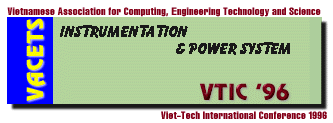
CLEAN POWER VARIABLE FREQUENCY DRIVES - A CASE STUDY
Diep Nguyen
Carollo Engineers
Walnut Creek, California, USA
Abstract
In the 90s, power quality has become a major concern for both the utilities
and the consumers because of the increasing use of non-linear loads such
as variable frequency drives (VFDs). While there are many benefits associated
with the use of the VFDs such as energy saving, they, due to the inherent
design of the power electronic components, can cause voltage and current
distortions better knows as harmonics which can affect the operations of
motors, transformers, protective relays and other sensitive electronic
equipment connected to the same bus as the VFDs.
Recognizing this concern, IEEE Std 519-1981 was revised and later updated
to become IEEE Std 519-1992 which was issued in April 1993. This Standard,
also an ANSI Standard, addresses and limits the harmonics (voltage and current)
to acceptable values from both the utilities and the consumer's viewpoint.
It specifically requires that the harmonic indices for both voltage and
current at the point of common coupling (PCC) defined as the point between
non-linear loads such as the VFDs and other loads within an industrial
plant be as low as 5 percent in some cases.
In order to meet this stringent new limit, in general, most medium size
(150 hp and larger) VFD system must be designed such that the reactors and
external harmonic filters and/or multiple pulse (above 6-pulse) converters
are used. The filters are designed to trap the unwanted harmonics which
are predominantly 5th (300 Hz) and 7th (420 Hz) generated by 6-pulse VFDs.
Unfortunately, external filter solutions generally require thorough harmonic
studies, system computer modeling, automatic control of the filters'
connection and periodic tuning of the system parameters in order to avoid
system resonant conditions. In addition, the total filter capacitance
must be properly sized to prevent the power factor of the system becoming
leading which is highly undesirable.
In the past couple years, several VFD manufactures are offering so-called
"Clean Power Drives." These drives are designed to meet the distortion
limits for both voltage and current at the drives' input regardless of how
weak or stiff the power system source is. This paper presents a case study
of an industrial application using clean power drives for a water pumping
station. This installation successfully meets all stringent requirements
of the IEEE Std 519-1992 at the drives' input.
COST ALLOCATION STRUCTURES AND ELECTRIC UTILITY DEREGULATION
Nguyen Tranh Chieu, Ph.D
21 Dartmouth Road
Mountain Lakes, New Jersey 07046 USA
Tel: (201) 263-6254(W), (201) 299-0019(H)
Fax: (201)263-6473
E-Mail: [email protected]
Abstract
Taking off from the power pooling concept whereby a group of electric
utilities collaborate to coordinate their activities with regard to the
generation and transmission of electricity, normative cost allocation
structures for the deregulated electric power industry are proposed.
Derivations of the cost allocation schemes are made for both the short-run
energy exchange pool as well as for the long-run central planning pool
using the duality theory of linear programming. Benefits of the proposed
structures regarding the adaptability of power pools in the changing
regulatory environment as well as policy implications on transmission
access are discussed. Applicability of the structures to the electric
industry in developing countries are also discussed.
EXPERIENCE WITH DEPLOYING CLIENT-SERVER TECHNOLOGY
Khai D. Le and Mai Nguyen
ABB Power T&D Inc.
Cary, North Carolina, USA
Abstract

